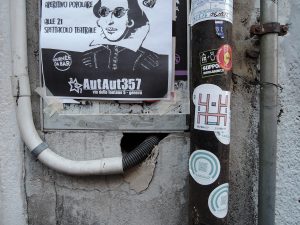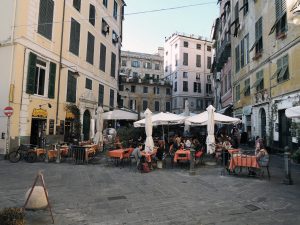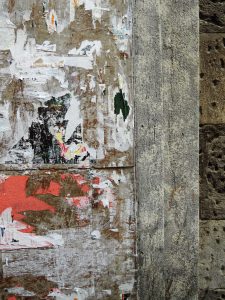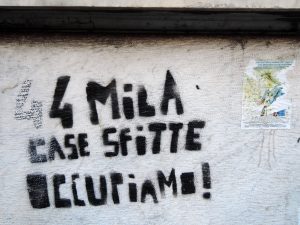
By Anke Schwarz
Tapulli at Piazza dell’Erbe, Genoa 2017 *
PART I: Interview with members of the Tapullo collective, Genoa
29 May, 2017 — Building something together is in itself a good way to create a community
Wireless community networks have been around for a while, but are regaining some attention these days as means of strengthening local interaction and community organizing. The Tapullo project in Genoa was established in 2016 by a group of people, some of them members of the FabLab at the Laboratorio Sociale Occupato Autogestito Buridda squat (http://fablabgenova.it), with the aim of setting up a DIY wireless community network. The name is reflective of their approach: in Genoese dialect, tapullo roughly refers to a quick and simple improvision (such as repairing a broken frame with Gaffa tape). What is interesting about Tapullo is that rather than providing internet access, it was designed as a purely local mesh network from the very beginning, hosting a local service in the form of a publicly accessible community forum. In technical terms, the network’s nodes consist of ordinary Wi-Fi routers (either the TP-Link TL-WDR3500 or the much cheaper TP-Link Archer C50 model), and a LattePanda single board computer which acts as a web server for the Tapullo forum. Tapullo’s routers run a combination of OpenWRT software (https://openwrt.org/), a specific Linux distribution for embedded services including wireless routers, with LibreMesh (http://www.libremesh.org/) installed in top. A first access point was installed at the home of a Tapullo host in a building at Piazza dell’Erbe in downtown Genoa in January 2017, with additional nodes to follow in late 2017.
The interview with members of the Tapullo collective was conducted in written form between March and May 2017, and has been edited for clarity.
Let us begin with the most obvious question: Why did you opt for a purely local mesh network, as opposed to one (also) offering internet access?
We decided to avoid providing internet access because we recognize that it is already available almost everywhere in an affordable (or even free) and easily accessible manner. Our idea is to re-connect people on a local and physical level. We wanted to create a network allowing for communication on a level that is disconnected and not mediated by the infrastructures of large corporations. We also wanted to build a network that is not interested in collecting and profiling your data. By making our network from scratch, we intent to take a step back to look at what really constitutes a network and to show digital communication at its core, without 20 years of infrastructure built on top of it. Basically, it is a local, organic, additives-free network.
With respect to your programmatic name, which are the cracks in the urban fabric that you hope to ‘fix’ by implementing a local community network in Genoa’s city center?
We hope to ‘fix’ sociality at a local level, by extracting a tool (in this case, a Wi-Fi network and an internet forum) from the ecosystem of the internet, cleaning it and bringing it closer to the physical space, thus making it available just to those people who are present in a specific place in a specific moment in time. In our case, that is Piazza dell’Erbe in downtown Genoa (for now). The internet is a global discussion forum, whereas we as Tapullo hope to be a new, local forum. We believe in communication and sociality at a local level. Another issue important to explore is the medium itself, in this case the network.
How does it work? How can it be used properly? And how can we learn new tricks, to be employed elsewhere afterwards?
We take so many things for granted, but relatively few people really know and understand how our hyper-connected reality works. We want to change that by bringing infrastructure closer to the people who are using it.
Please go a bit into detail here: What exactly needs such ‘fixing’ in Genovese society? I understand that the stereotype is one of a rather introvert community – but what are the main local issues and struggles as you see it?
What we believe needs fixing is, firstly, what is already happening in every city: The isolation occurring between people even when they are physically socializing together. Tapullo allows you to de-isolate yourself using the same medium that is currently generating the isolation in the first place. It generates the possibility to interact on ludic-practical matters with the same people that you’re physically sharing a space with at that very same moment. Secondly, it tries to ‘fix’ the typical introvert/antisocial attitude of the Genoese, which is sometimes visible in the way they deal with ‘the other’, represented by people from other regions, international tourists or migrants. By making a platform that it is local yet accessible to all, we hope to bring down the barriers in our own mentality.
How far does the actual ‘power’ of a communication infrastructure go? To what extend could an instrument like Tapullo actually play a role in processes of (local) social transformation?
We don’t know yet, but we believe in the idea that building something together is in itself a good way to create a community, and by building a communication instrument like a Wi-Fi network, we want to push for something that is close to the community itself. Moreover, it can generate new interactions between different sectors or parts of society that normally do not communicate often (or at all).
Tapullo’s first node was installed at Piazza dell’Erbe in February 2017. What are you first experiences? How do you get people to use your network? Who uses Tapullo so far, and for which purposes?
At the moment, we don’t have enough data to answer this question. The project launched recently and for now, there are only a few active users. We launched Tapullo with a small campaign (stickers, postcards, word of mouth) but apparently, that was not enough to generate a critical mass. We plan to organize more events in the near future to increase the number of users and generate interest in the platform. A few of the proposals being currently discussed are an alleycat race, a treasure hunt, a photography contest, and audio/video/book sharing.
Have you thought of ‘hybrid’ strategies in which access to the internet is available, but is used in a different way (e.g. a website that can be ‘written’ by only those having access to the local network but read online by everyone)?
We are working on something similar: A public internet blog (http://tapullo.net/) where we will discuss the activities happening in the local network. This should make it easier for new people to discover Tapullo and also to keep users informed about what is going on without having to be at Piazza dell’Erbe all the time.
Will you organize any ‘physical’ events to discuss about the network with outsiders?
Yes, we are currently planning one or two theoretical and practical workshops on mesh networks. We want to discuss what these networks are and show how to build antennas and reflash Wi-Fi routers. Hopefully, that should bring more people in and also help us share the technical knowledge amongst ourselves.
As yet another social network, a critic could assume that Tapullo leads to ever more people glued to their screens, rather oblivious of their surroundings. What are your observations so far: Does communication via Tapullo and face-to-face interaction indeed blend over?
Tapullo has only a few active users for now. Yet we believe that users will not be overwhelmed by too much content, as the network is localized and only people physically present at Piazza dell’Erbe can add content. Practically, you can’t lose yourself scrolling down the page as you might in big social networks, at least for now. However, the amount of content is of course linked to the number of users and to the ease of adding new content. The fact that Tapullo is localized restricts these two factors and limits the abuse. If we consider the Internet a window open to the world, our network wants to be like a stroll: you leave the house to change your perspective. That includes an active practice (going out, walking) instead of a more passive one (looking out of a window, browsing the Internet).
How could an alternative communication infrastructure such as Tapullo support ongoing local struggles over the right to the city, for instance with respect to squats and affordable housing in Genoa?
On a philosophical level, we build a virtual space in the same way that you would occupy an abandoned building to repurpose it as a social center for the greater good of the community. In that sense, by re-appropriating them, we want to state the idea that spaces, whether physical or virtual, belong to the communities that inhabit them. Moreover, the virtual space of Tapullo itself may serve as a virtual board or display, increasing the visibility of local struggles.
Are you in contact with local ‘right to the city’ (or other) urban activists, and if yes, has it been easy to communicate Tapullo’s vision to these people engaged in similar struggles in a different context?
Over the past months, we have been talking about the project with many activists, some of them involved in urban struggles, but we haven’t yet built anything together. We do believe that it is fundamental to have a broad, diverse group of activists collaborating on the project, and that this is going to happen organically, over time, as soon as the network builds enough momentum.
You are based in Genoa’s FabLab, but how strongly is Tapullo actually about making or peer production? Aren’t you acting more like a service provider, at least in the beginning?
As we said above, we want to return to the basics of the tool itself. Obviously, our platform is open and accessible to everyone, but the main idea is to bring attention to the method and potential of the tool itself by sharing knowledge on how it works, how to expand it, how to offer more services. Offering services by making them, step by step.
The Tapullo collective is from a leftist/autonomous context, yet you deliberately adopted a neutral stance when launching the community network – rather than explicitly linking it to the FabLab, for instance. Why did you opt for this position?
We decided not to put it under the Buridda or FabLab name because that was never discussed on a general assembly in these two groups. You might say the collective doesn’t represent the whole but only a subset of it. Plus, the idea of installing the network in the city center (instead of in the squat, which is in a different neighborhood) made us think that it doesn’t make sense to directly link it to Buridda or FabLab if we wanted to give it a broader audience in the city.
In technical terms, which are the lessons learned from other wireless community networks? Why did you develop your own hardware/software set-up instead of simply implementing one of the existing concepts such as Ninux (Rome) or AWMN (Athens)?
Our setup is quite simple actually. The Wi-Fi part is handled by the LibreMesh firmware running on a TP-Link router. That same firmware is developed and used by Ninux. For the forum we are using a LattePanda board, which is slightly more powerful than a Raspberry Pi. Why that specific board? Because that’s what we had at hand without having to buy new hardware.
Please explain how you deal with the challenges of operating a wireless community network. What are your thoughts about governance issues related to data storage and private information once the Tapullo network grows? For instance, do you keep any records or user data that might be accessed by friendly or hostile third parties?
We have no plans to collect traffic data, that much is clear. All data ending up on the forum is by definition considered public and thus available to everyone to read. Also, there is no ‘real name policy’, so everyone is free to register an anonymous/pseudonymous nickname. We don’t have any privacy-sensitive service running at the moment, though we might have some in the future. We haven’t really planned much beyond this point (yet) – beside the fact that we do not want your data, now or in the future.
What next for Tapullo? What are your thoughts about the network’s future ownership in terms of its operation, maintenance, and expansion?
We would like to have more users and share the knowledge required to maintain and expand the network with them. Our dream is that Tapullo grows up over time, like a child, so that at some point in the future it becomes autonomous and independent, self-organizing – until the very moment when we can finally shut down the first Wi-Fi router without affecting the network’s functionality because the network itself will have made this first node redundant.
PART II: Remaking Genoa? Urban DIY Mesh Networks and the Right to the City
31 October, 2017
To the visitor, Genoa’s historical center sometimes resembles a confusing set of narrow, cobbled alleyways, with sky-high medieval palaces and densely arranged buildings often creating a canyon-like impression. On the ground, orientation can be difficult, with hardly any clear sky or celestial bodies in sight. Depending on the location (and perhaps more important these days), GPS and mobile internet access are also limited, disrupting digital navigation attempts. An urban environment apparently so hostile to mobile communication and digital services might somehow help keep the destructive effects of mass tourism at bay. However, it also harbors the wireless community network Tapullo. As the walls bespeak the rich social activity and urban movements the area is traditionally teeming with, this seems only logical. Until recently, street corners and sign posts in the Centro storico were covered with posters and stickers for a variety of leftist and autonomous events and causes, from punk concerts, collective dinners and workshops at one of the squatted social centers to the Movimento di lotta per la casa’s marvelous crowbar logo.
Piazza dell’Erbe
I first interviewed members of the Tapullo collective in May 2017. A first node of the prospective mesh network had just been installed in Piazza dell’Erbe, a relatively large public square in downtown Genoa, packed with bars and brimming with mostly younger people in the evenings. This seemed to be the perfect crowd to engage in a local mesh network based on both virtual and face-to-face interaction: Social-media-affine youngsters at their favorite watering hole. There was a palpable enthusiasm in the collective. Yet when I returned in October 2017, the mood had somewhat changed. In a curious turn of events, Tapullo’s one and only node had been damaged: The transformers of both the Wi-Fi router and the LattePanda single board computer had completely burned out, along with laptops, fridges, and a bunch of other electrical devices in the building where the Tapullo host lives. The damage was caused by a flawed power line installation by a technician from ENEL, Italy’s leading energy provider. Consequently, the equipment had to be removed for repairs, and the Tapullo forum was down for several weeks. This episode serves as a reminder to the multiple manners in which other urban infrastructures and social networks underpin a seemingly independent DIY mesh network. Moreover, it draws attention to the effort and time required to install and maintain such a wireless network as Tapullo moved away from its reliance on a single access point. A second phase, where the signals from individual nodes are woven into a mesh, was imminent – just as a notable shift in urban governance in downtown Genoa highlighted the need for collective social (inter)action. Ever since a change in city government in June 2017 brought an entrepreneur running as an independent candidate for the populist right-wing alliance between Forza Italia and Lega Nord into the position of mayor, a 1990s-style law-and-order approach to public space seemed to be gaining pace. After decades of social democratic rule by the Partito Democratico and its predecessors, this represented a rupture for the city home to one of the major seaports in the Mediterranean and once known as a leftist bastion. Some of Genoa’s seven occupied centri sociali may soon face the threat of eviction – and this development comes at a time when neofascists are seeking to establish two new premises in the city. Given the present political situation, it is not hard to predict an increase in urban struggles in the near future. This applies in particular (but not only) to the historical center, where a new regulation prohibiting the consumption of alcohol in public is being discussed. On a more symbolical level, the removal of political posters and graffiti is combined with a widening of an existing city marketing campaign, launched in 2014 under the somewhat comical slogan ‘Genova – more than this’. As the scraped-off posters illustrate, such attempts to sanitize public spaces and render leftist and progressive autonomous voices invisible form part of the new city government’s strategy. Meanwhile, parts of the new administration are pushing an anti-migrant and zero tolerance discourse.
Contested wall
Parts of downtown Genoa are traditionally home to poorer inhabitants and migrant communities, and apart from the centri sociali (which are typically located in derelict industrial or private buildings outside the city center) there are several ‘silent’ occupations of flats exclusively for housing purposes. The existing struggles against marginalization and displacement are captured nicely in the spirit of a graffito that reads “44.000 vacant homes, let’s occupy!”. For Tapullo, the present situation raises interesting questions over the platform’s future audience and usership in its second, increasingly more networked phase. Will it merely evolve into some kind of small, independent service provider, feeding a pattern of individual consumption – or accomplish a more collective approach?
44.000 vacant homes, let’s occupy!
If we wish to read the right to the city, at its core, as a collective rather than individual “right to change ourselves by changing the city” (Harvey 2008: 23), this is precisely where DIY mesh networks like Tapullo come into play. In the present historical situation, defending our ‘digital rights to the city’ (as a recent collection of essays edited by Shaw and Graham 2017 has it) against big tech companies and governmental intrusion alike is certainly paramount. Yet instead of evoking notions of data mining, privacy breaches, surveillance and control typically related to the most widespread information and communication technologies (ICT), such collectively owned digital platforms may well support and further different urban futures (for details, see Antoniadis and Apostol 2014; De Filippi and Tréguer 2015). As Paolo Cardullo observes in his recent study of London’s wireless community network OWN, these networks “operate by strengthening social interactions and relations on the ground, rather than in an imaginary cloud-space. The cultural disposition of people directly involved in using the wireless network is (…) the crucial element that sustained the mesh” (Cardullo 2017: 7). An insurgent peer production of the urban is nourished by social interactions in a material and virtual sense, based on common interests and/or a shared cause. Given both the existing social movements and the looming wave of contestation over public space and centri sociali in Genoa, a host of potential alliances could be activated and deepened by weaving this network tighter, and thus assembling a city for all. Not only in name, the “patchwork improvisation” (Cardullo 2017) of the Tapullo mesh network is thus both dependent on and productive of an urban commons. In October 2017, four fresh routers lay in wait to be installed as new Tapullo nodes in the city center. As members of the collective were in the process of recruiting future hosts amongst local organizations and pubs, probably one of the most pertinent questions for the near future is: Who is remaking Genoa, and in which image?
References
Antoniadis, P. and Apostol, I. (2014): The Right(s) to the Hybrid City and the Role of DIY Networking. In: Journal of Community Informatics 10 (3), http://ci-journal.net/index.php/ciej/article/view/1092/1113
Cardullo, P. (2017): Gentrification in the mesh? An ethnography of Open Wireless Network (OWN) in Deptford. In: City. http://dx.doi.org/10.1080/13604813.2017.1325236
De Filippi, P. and Tréguer, F. (2015): Expanding the Internet Commons: The Subversive Potential of Wireless Community Networks. In: Journal of Peer Production #6 http://peerproduction.net/issues/issue-6-disruption-and-the-law/peer-reviewed-articles/expanding-the-internet-commons-the-subversive-potential-of-wireless-community-networks/
Harvey, D. (2008): The Right to the City. In: New Left Review 53, 23-40. https://newleftreview.org/II/53/david-harvey-the-right-to-the-city
Shaw, J. and Graham, M. (eds.) (2017): Our Digital Rights to the City. Meatspace Press. https://meatspacepress.org/our-digital-rights-to-the-city/
PART III: The future of Tapullo
31 January, 2018
The members of the Tapullo collective wish to continue their effort to build a local mesh network and if they succeed to keep their project running you will be hearing about their progress at:
http://tapullo.net (in Italian)
About the author
Anke Schwarz is an urban geographer and postdoctoral researcher at Technical University of Berlin. She is mainly interested in processes of urban transformation, urban infrastructures and everyday life. Her book ‘Demanding Water. A Sociospatial Approach to Domestic Water Use in Mexico City’ was published in 2017. https://ankeschwarz.net/
* All pictures by Anke Schwarz




